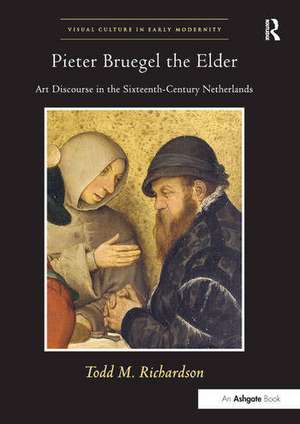Pieter Bruegel the Elder: Art Discourse in the Sixteenth-Century Netherlands: Visual Culture in Early Modernity
Autor ToddM. Richardsonen Limba Engleză Paperback – 14 oct 2016
Din seria Visual Culture in Early Modernity
- 22%
 Preț: 324.16 lei
Preț: 324.16 lei - 18%
 Preț: 1061.84 lei
Preț: 1061.84 lei -
 Preț: 311.37 lei
Preț: 311.37 lei - 9%
 Preț: 1022.27 lei
Preț: 1022.27 lei -
 Preț: 312.12 lei
Preț: 312.12 lei -
 Preț: 356.70 lei
Preț: 356.70 lei -
 Preț: 336.27 lei
Preț: 336.27 lei -
 Preț: 432.98 lei
Preț: 432.98 lei - 17%
 Preț: 343.55 lei
Preț: 343.55 lei - 25%
 Preț: 324.16 lei
Preț: 324.16 lei - 30%
 Preț: 769.92 lei
Preț: 769.92 lei - 13%
 Preț: 338.33 lei
Preț: 338.33 lei - 22%
 Preț: 259.98 lei
Preț: 259.98 lei - 25%
 Preț: 326.11 lei
Preț: 326.11 lei -
 Preț: 471.08 lei
Preț: 471.08 lei - 28%
 Preț: 826.84 lei
Preț: 826.84 lei - 28%
 Preț: 819.90 lei
Preț: 819.90 lei - 28%
 Preț: 878.42 lei
Preț: 878.42 lei - 28%
 Preț: 829.69 lei
Preț: 829.69 lei - 25%
 Preț: 325.43 lei
Preț: 325.43 lei - 30%
 Preț: 853.03 lei
Preț: 853.03 lei - 17%
 Preț: 339.96 lei
Preț: 339.96 lei - 30%
 Preț: 830.92 lei
Preț: 830.92 lei - 16%
 Preț: 338.33 lei
Preț: 338.33 lei - 30%
 Preț: 826.02 lei
Preț: 826.02 lei - 30%
 Preț: 772.60 lei
Preț: 772.60 lei - 18%
 Preț: 1017.63 lei
Preț: 1017.63 lei - 30%
 Preț: 768.62 lei
Preț: 768.62 lei - 17%
 Preț: 338.33 lei
Preț: 338.33 lei - 30%
 Preț: 771.07 lei
Preț: 771.07 lei - 30%
 Preț: 772.76 lei
Preț: 772.76 lei - 16%
 Preț: 347.33 lei
Preț: 347.33 lei - 31%
 Preț: 765.03 lei
Preț: 765.03 lei -
 Preț: 489.26 lei
Preț: 489.26 lei - 28%
 Preț: 822.91 lei
Preț: 822.91 lei - 18%
 Preț: 300.09 lei
Preț: 300.09 lei - 26%
 Preț: 820.73 lei
Preț: 820.73 lei - 28%
 Preț: 829.69 lei
Preț: 829.69 lei - 28%
 Preț: 826.84 lei
Preț: 826.84 lei - 30%
 Preț: 776.03 lei
Preț: 776.03 lei
Preț: 324.84 lei
Preț vechi: 439.94 lei
-26% Nou
Puncte Express: 487
Preț estimativ în valută:
62.17€ • 64.66$ • 51.32£
62.17€ • 64.66$ • 51.32£
Carte tipărită la comandă
Livrare economică 14-28 aprilie
Preluare comenzi: 021 569.72.76
Specificații
ISBN-13: 9781138252806
ISBN-10: 1138252808
Pagini: 272
Dimensiuni: 174 x 246 x 30 mm
Greutate: 0.49 kg
Ediția:1
Editura: Taylor & Francis
Colecția Routledge
Seria Visual Culture in Early Modernity
Locul publicării:Oxford, United Kingdom
ISBN-10: 1138252808
Pagini: 272
Dimensiuni: 174 x 246 x 30 mm
Greutate: 0.49 kg
Ediția:1
Editura: Taylor & Francis
Colecția Routledge
Seria Visual Culture in Early Modernity
Locul publicării:Oxford, United Kingdom
Cuprins
Contents: Preface; Introduction; Vernacular discourse and the art/nature debate; Art, conversation, and the convivium tradition; Feast your eyes, feast your mind; Classicizing the popular or popularizing the classics; He that cometh after me; To see yourself within it; Conclusion: Hans Vredeman de Vries and Pieter Bruegel: an artistic confrontation; Bibliography; Index.
Notă biografică
Todd M. Richardson is an assistant professor of Renaissance and Baroque Art History at the University of Memphis, USA. He is also co-editor of The Transformation of Vernacular Expression in Early Modern Arts (2011) and an editor for the book series, Proteus: Studies in Early Modern Identity Formation.
Recenzii
'... Richardson provides a detailed visual analysis of the painter‘s artistic intentions... Recommended.' Choice
'Richardson‘s major contribution lies in reminding us of the artistry of Bruegel‘s art, its sophisticated awareness of the complex artistic milieu in which it was produced.' Renaissance Quarterly
'... to the often-repeated thesis that Bruegel‘s contemporaries responded to his paintings chiefly by deciphering their disguised symbolism, Richardson offers a more plausible alternative, which deserves further exploration.' Burlington Magazine
'Richardson‘s major contribution lies in reminding us of the artistry of Bruegel‘s art, its sophisticated awareness of the complex artistic milieu in which it was produced.' Renaissance Quarterly
'... to the often-repeated thesis that Bruegel‘s contemporaries responded to his paintings chiefly by deciphering their disguised symbolism, Richardson offers a more plausible alternative, which deserves further exploration.' Burlington Magazine
Descriere
Pieter Bruegel the Elder: Art Discourse in the Sixteenth-Century Netherlands examines Bruegel's later paintings in the context of two contemporary discourses-art theoretical and convivial. Taking a multi-disciplinary approach, the author analyzes a variety of images, texts and historical records to offer a broader understanding of not only the artist, but also of the vibrant artistic dialogue occurring in the Netherlands during the sixteenth century.
